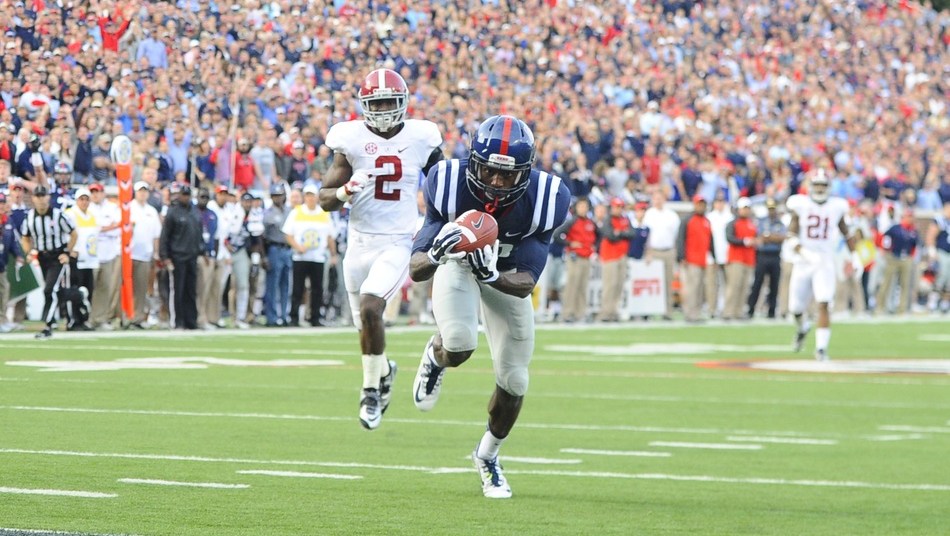Who can take advantage of Mississippi State's secondary?
Just like every other team in the country, Mississippi State is not perfect; despite a perfect 7-0 record, the Bulldogs secondary has been exposed as the team’s weakest link.
It’s not like the Bulldogs secondary is a talentless bunch. They’ve picked off 11 passes so far this season, while only giving up 13 touchdowns. They’ve broken up 39 passes as well, with cornerbacks Jamerson Love and Taveze Calhoun, as well as safety Tolando Cleveland leading the way in that department.
They’ve also given up some garbage time passing yards, as they did against LSU and Texas A&M. While those yards and touchdowns count on their totals, they’re not quite as impactful as first quarter touchdowns.
There’s still plenty of football to be played, but it’s getting to that point where observers can start to peek ahead at the schedule. MSU has four SEC games left: this weekend against Arkansas, Nov. 15. at No. 3 Alabama, Nov. 22 against Vanderbilt and Nov. 29 at rival No. 7 Ole Miss. Fit in the middle is a date with Tennessee-Martin on Nov. 8. Will any of them be able to exploit the Bulldogs’ biggest weakness?
Off the bat, Vanderbilt and UT-Martin can be ruled out. Not to be harsh, but neither has the talent to topple the Bulldogs. This weekend, Arkansas will be pitting its offensive strength, a powerful running game, against Mississippi State’s stingy run defense. Brandon Allen is a capable quarterback for the Razorbacks, but he doesn’t have many downfield weapons.
That leaves two teams, both with senior quarterbacks and threatening weapons at receivers, that may be able to take advantage: the Crimson Tide and the Rebels. Blake Sims and Bo Wallace, despite the criticisms levied at them (more so in Wallace’s case than Sims’), are both among the best quarterbacks in the SEC. Alabama’s Amari Cooper is the best receiver playing on Saturday’s, while Ole Miss has a talented trio in Laquon Treadwell, Vince Sanders and Cody Core.
Which team is better built to knock off No. 1? First, a look at both teams’ passing numbers this season:
- Alabama: 2,322 yards, 18 TD, 3 INT, 65.1 percent completion rate, 30.1 attempts per game, 9.6 yards per attempt, 8.2 yards per attempt, 290.3 yards per game, 35 20-plus yard plays, 18 30-plus yard plays
- Mississippi: 2,150 yards, 18 TD, 7 INT, 62.2 percent completion rate, 32.8 attempts per game, 268.8 yards per game, 31 20-plus yard plays, 15 30-plus yard plays
And Mississippi State’s pass defense numbers:
- 2,250 yards allowed, 13 TD, 11 INT, 52.9 percent completion rate, 44 attempts per game, 7.3 yards per attempt, 321.6 yards allowed per game, 30 20-plus yard plays allowed, 14 30-plus yard plays allowed
Mississippi State’s pass defense is indeed struggling, giving up the most 20- and 30-plus yard plays in the SEC, but they also give up big yardage totals simply due to attrition. Teams throw and throw against the Bulldogs — the 44 pass attempts they see per game are most in the SEC — both because their secondary is perceived as their weakness and because teams have been down to them early.
Alabama is a team that, despite a revamped offense under Lane Kiffin, would still like to run the ball as its first option. When they do throw, it’s more than likely going to Cooper. According to the statistics website ncaasavant.com, Cooper has been targeted on 42.9 percent of Alabama’s pass attempts this season, the highest such percentage in the country.
Ole Miss, meanwhile, has three receivers that are targeted on 15 percent or more of its pass attempts: Treadwell (25.4), Sanders (15.9) and Core (15.5), as well as tight end Evan Engram at 11.6 percent. Those diverse options make the Rebels a little harder to defend, although stopping Cooper is no walk in the park. The difference is that Ole Miss runs the ball far less effectively than Alabama, averaging nearly two fewer yards per carry on a similar number of attempts.
Both teams have struggled when their running games have been stonewalled, but Alabama is much more equipped to weather that kind of storm than Ole Miss. The Tide’s offensive line is loaded with talent, is coming together health-wise at the right time and is shrugging off some early-season rough patches. The Rebels don’t have anywhere near the backfield talent of even a depleted Alabama backfield, and their offensive line is shaky at best.
We saw this past Saturday what can happen to the Rebels if Wallace sees pressure. He was just 14-of-34. While LSU’s secondary is stronger than Mississippi State’s, the multiple near-interceptions Wallace threw won’t be dropped every time.
Sims has made some questionable throws for Alabama as well, totaling at least three dropped interceptions in the last three games, but his have come more from simply poor throws than reactions to pressure.
When it comes down to it, the teams’ ability to slow down Mississippi State’s defensive line will probably be the biggest factor in which can best take advantage of Mississippi State’s secondary. That advantage goes to Alabama. Additionally, Sims has the best weapon in college football, as Cooper is capable of both beating a secondary deep and by burning teams with runs after the catch.
Mississippi State’s road to Atlanta isn’t going to be easy. The secondary will be tested. Will they be up to the task?

